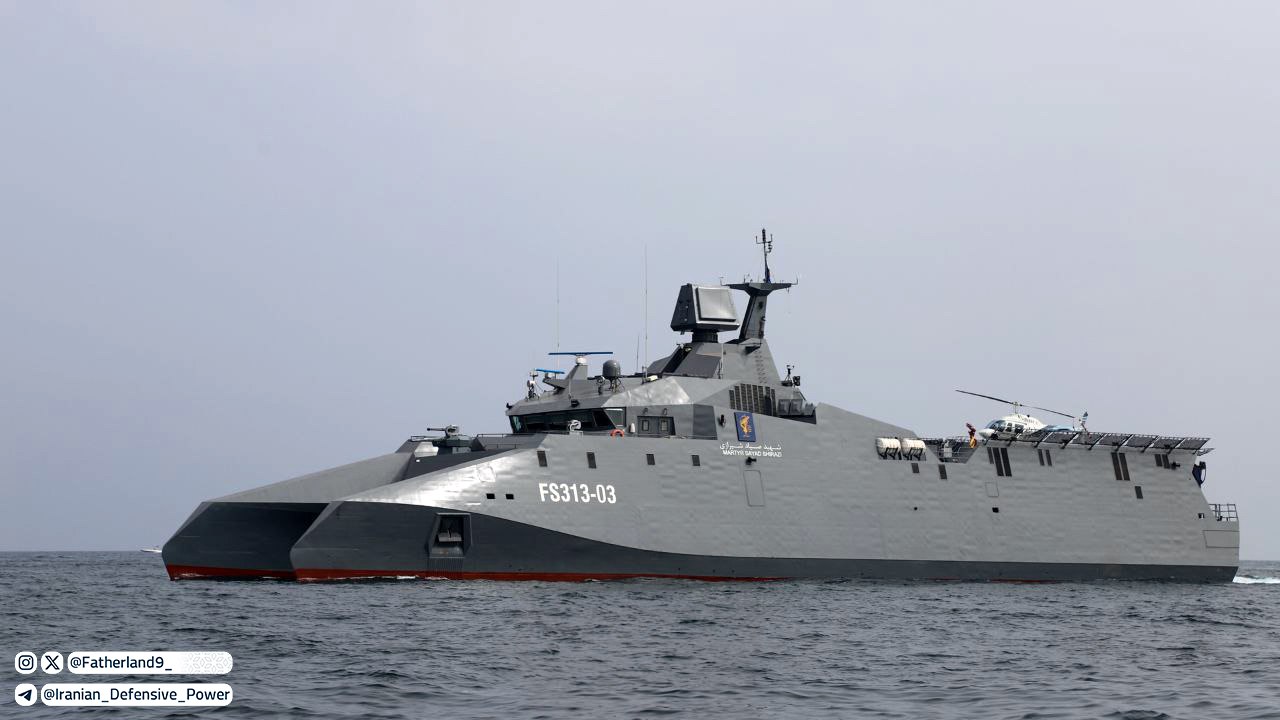Iran recently launched two Shahid Soleimani-class missile catamarans. While they showcase the nation’s shipbuilding and military electronics development, they do not have the teeth to challenge and counter drones and unmanned systems – extremely essential for today’s warfare.
The Islamic Revolutionary Guard Corps Navy (IRGCN) on February 19 launched two more Shahid Soleimani-class missile catamarans, the Shahid Hassan Bagheri and the Shahid Sayad Shirazi. The ships appear to have a patrol-and-surveillance-oriented role, largely couched in the asymmetric capabilities Iran relies on.
While experts note that the ships leave a lot to be desired in terms of armament payload to make them relevant to today’s threats involving drones and unmanned systems, they mark a significant leap in Tehran’s shipbuilding and military electronics development.
Ship Characteristics
The Shahid Soleimani catamarans have a length of 67 meters, a displacement of about 600 tons, and can be classified as corvettes. “For their displacement, they have a significant and sophisticated combination of missile and gun weapons,” noted an Indian Navy Commander-rank officer speaking to EurAsian Times.
The missile payload includes six inclined launchers for various types of Iranian anti-ship cruise missiles (the range of the longest-range missiles is stated to reach 700 km); 16 Nawab naval air defense missiles in universal vertical launch (UVL) silos; and another six unidentified missiles in a much larger UVP, probably for the previously shown modification of Sayyad 3 medium-range anti-aircraft missiles with vertical launch.
Gun systems include a 30-mm gun mount and six three-barreled 20-mm remote-controlled stations. In addition, the ships have a platform for helicopters and a crane in the stern to launch small boats, including unmanned ones.

However, not all the three vessels have the designated integrated radar, according to Iranian defense affairs experts. ‘fatherland9’, a leading handle on X (formerly Twitter), said that the first vessel of the class, the Shahid Soleimani, “has a temporary radar to test the Nawab air defense missile.”
The second ship of this class, Shahid Hassan Bagheri (FS313-02), seems to sport a radar and a different gun mount turret. “Finally, we see the third ship of the Shahid Soleimani class, named Shahid Sayad Shirazi (FS313-03), which finally received the main radar of this class.” This radar on the Sayad Shirazi is expected to be used in the test of the Sayad-3F missile.
The Sayyad is a series of air defense missiles, with the latest version, the ‘Tactical Sayyad,’ unveiled in August 2023. It appears that the system has been adopted for naval use as well.
Expert Speak
The catamarans have their share of strengths and drawbacks. One of the ships’ advantages is the on-board air defense systems that can counter drones.
Noted Russian defense expert Yuri Lyamin, quoted in the leading Russian military analysis forum Rybar, drew attention to the fact that the crane located at the stern of the catamaran can be used to lift/lower both manned and unmanned boats, “which is also relevant in our time.”
• باتوجه به تصاویر، فروند اول کلاس شهید سلیمانی بهنام شهید سلیمانی (FS313-01) به یکرادار موقت جهت آزمایش موشک پدافند هوایی نواب مجهز است؛ فروند دوم این کلاس بهنام شهید حسن باقری (FS313-02) برجک اصلی ناو را دریافت کرده اما هنوز رادار اصلی این کلاس را دریافت نکرده است.
۲/۳ pic.twitter.com/nH1C6LB7ZZ
— فادرلند (@fatherland9_) February 19, 2024
Little is known about Iranian projects in the unmanned surface vessel (USV) or Unmanned Underwater Vehicle (UUV) arena. However, the crane will be used when operating such remotely controlled maritime platforms.
‘No Lessons from Black Sea War?’
Judging by the appearance and information from open sources, the ship does not have any “anti-submarine defense systems,” which is undoubtedly a big drawback. Neither does it appear that Iranian naval designers have incorporated any lessons from Ukraine and Russia’s experience in the Special Military Operation (SMO).
The design and development of the ships must have begun much before the war because modifications were not incorporated during the construction phase. The same can be said about the absence of hydroacoustic systems (HAS), which were not visually noticed. The asymmetric war in the Black Sea shows that the ship’s observation posts by ‘watch officers’ can barely detect “semi-submersible” one-way kamikaze drone boats before they fire and manage to destroy them. “With underwater ones, everything is much more complicated; thus, without HAS, the ship will be very vulnerable,” Rybar said.
Iran also seems to have committed the same mistakes as Russia’s naval planners, where small missile or patrol boats are also “not equipped with means and weapons” to “make them capable of fighting” kamikaze USVs and submersibles. “If the Iranians at least have on-board air defense, then our ships of projects 22160 and 21631 do not have even this (the Tor air defense systems installed on the deck certainly do not count),” Rybar added.
Project 22160 are long-distance patrol ships designed for the Black Sea fleet, armed with an AK-176MA-01 firing 76.2-mm rounds, a Klub-N ship-launched land-attack missile, and a Palma anti-aircraft missile and gun system.
Project 21631 Buyan-M-class corvettes have a 100-mm A-190-01 naval main gun; two 30-mm AK-630-M2 rapid firing Gatling-guns as Close-In Weapons Systems (CIWS); a Pantsir-M CIWS; eight launchers for Kalibr or Oniks anti-ship cruise missiles; and eight Komar surface-to-air missiles.
This loadout is not suited for fast-moving, stealthy, and cheap suicide USVs, which need specialized radars, optical sensors, and more rapid-firing CIWS systems for detection and engagement.
- The author can be reached at satamp@gmail.com
- Follow EurAsian Times on Google News




